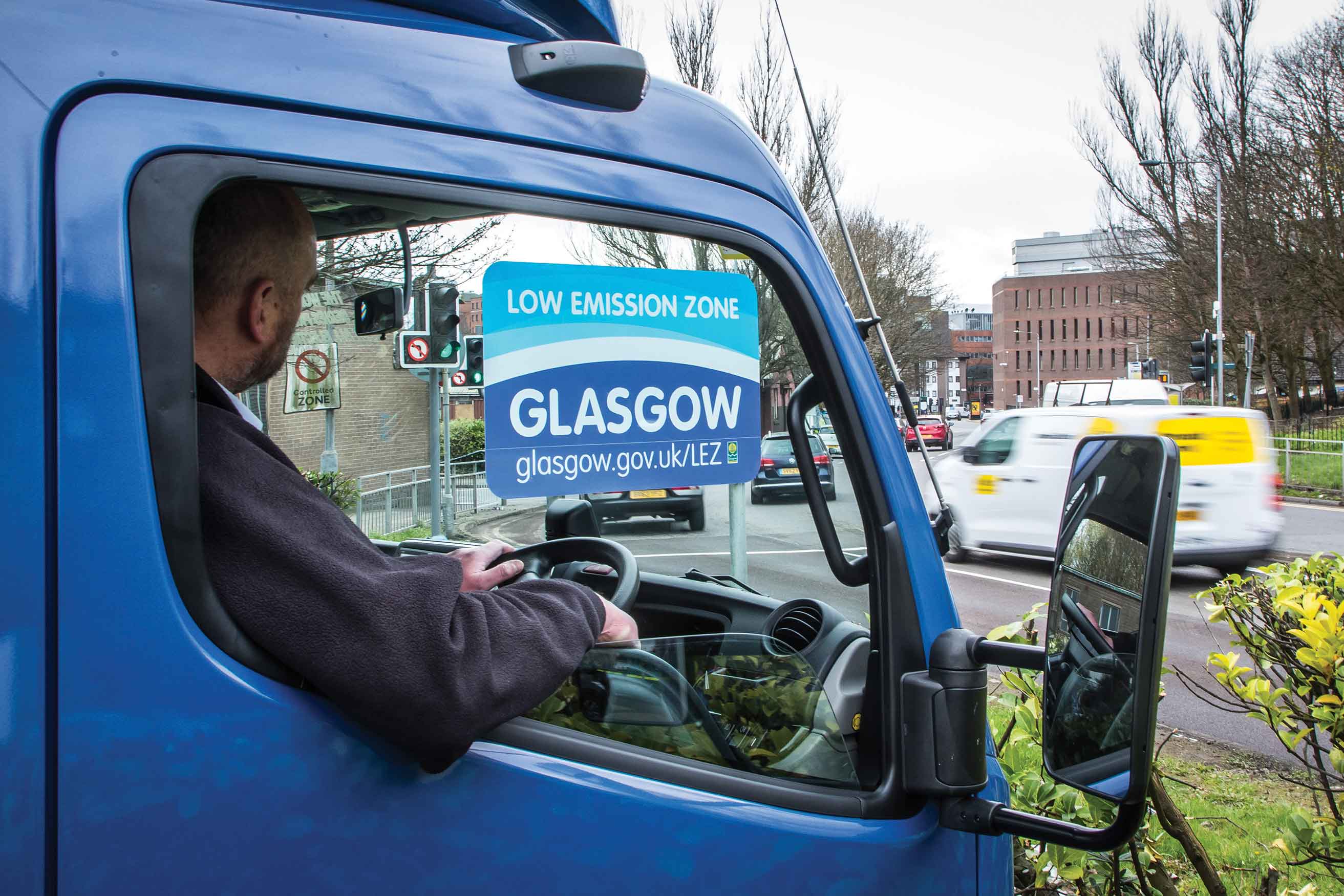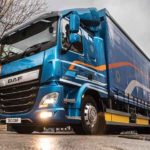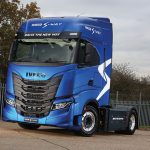
It seemed an ideal opportunity to drive the electric powered Fuso eCanter following the Transport News’ Clean Air Roadshow at Hampden Park, and it raised a few eyebrows within Glasgow’s Low Emission Zone! Kevin Swallow reports.
MY FIRST experience of an electric vehicle was a Morrison-Electricar milk float. Built in 1966 it patrolled the streets of a Somerset village for more than 30 years. I never drove it, I was 13 at the time and only spent two days on it lightening the load one milk bottle at a time.
It had a top speed of around 15mph, a range of 80 miles, and it took eight hours to recharge, I know this because I was told, repeatedly, by its owner. Put off by the 4am starts and the repeated technical profiling of the milk float, I pursued a career as a paperboy because it allowed me to stay in bed for an extra two hours.
Some of those stats associated with the Morrison-Electricar sprang to mind as I got my first look at a Fuso eCanter. Launched in Japan in 2017, then the following year in Europe, the eCanter will go on general sale through the Mercedes-Benz dealer network in 2020. That said, some businesses are already using it (see sidebar).
Momentum is generated by a BorgWarner Remy electrical motor, which is powered by six 420V and 13.8kWh lithium-ion batteries. Its electric drivetrain with permanent-magnet motor delivers 173hp via a single gear transmission.
According to Fuso, recharging from zero to 80% takes an hour using the DC (one direction ‘direct current’ charge), with the remaining 20% taking up to two hours, or you can charge it on AC (alternating current that changes direction) adaptor from zero to 100% in nine hours.
And that is pretty much it. All the technology is built into the chassis, the motor is in the middle and the batteries are on either side. Warranty is three year unlimited mileage with a 10 year cover on the high-voltage batteries, service intervals are every two years or the best part of 25,000 miles.
The cabover has three seats, air conditioning, a radio and two coffee cup holders.
With a range of 62 miles the eCanter couldn’t embrace the traditional Transport News distribution route, as it would only have reached J12 of the M74 from Carlisle, long before Glasgow’s Low Emission Zone (LEZ). So, to emphasise the green credentials, we took the truck from Transport News Scotland’s Clean Air Roadshow at Hampden Park, Glasgow to the city’s LEZ.
FIRST LEZ
For the record, this is Scotland’s first LEZ, and it came into effect on 31 December 2018. It is a phased integration beginning with the local buses. On 31 December 2022 it will be ‘fully implemented’ for all vehicles entering the zone to have the specified exhaust emission standards. It is surrounded to the north and west by the M8 motorway and to the south by the River Clyde. To the east the boundary is the A8 from Saltmarket north to High Street, then Castle Street to the M8 J15. It covers 640 acres.
To start the eCanter you insert the key fob, make sure the gearstick is in P for park, apply the footbrake and press the start/stop button long enough for the ‘ready light’ on the dashboard to stop flashing. Then move the gearstick to D, for drive, and release the handbrake and take your foot off the brake pedal.
It’ll move forward without any prompting from the accelerator, but should you apply pressure to the pedal it’s worth noting that you will find yourself 50 metres down the road before you realise what is going on.
Despite the somewhat rapid start, the eCanter is limited to 50mph, primarily to prevent damage to the motor due to overcharging. In fact, there is a guide in the dashboard as to how much distance you have left and how quickly you are draining the battery. Green is ‘charge’ and blue is ‘eco’, whereas the final third, which is white, drains the battery quickly.
Going gentle on the accelerator keeps the needle in blue and best maximises the distance. Glasgow’s LEZ is a series of one way streets that criss cross the city’s square mile. The eCanter happily mingled with the buses, taxis, vans and handful of rigid trucks that occupied the city centre that day.
It kept pace with everything. It handled like a normal Canter as regards lateral movement, and with a 12.2m turning circle, it can be swung around and pointed in the opposite direction quickly and without stress.
The footbrake will bring the eCanter to a halt in a timely fashion, as will the single stage engine brake on the stalk on the right hand side of the steering column, which increases regenerative braking, so you can choose either method.
Most significant is the noise. It is quiet with a constant humming noise that rises as the truck increases speed.
After six hours with the ignition on throughout, the eCanter used the equivalent of ‘35 miles’ before we rolled into Western Commercials, the Mercedes-Benz and Fuso dealership in Govan, for a well earned break. It is no different to driving any vehicle powered by a fossil fuel and that, of course, is the point.
Its recommended retail price will be proffered next year when it goes on general sale, in the meantime those currently using it have had to lease the eCanter.
While its green credentials are to be applauded, operators are pragmatists and the economic cost of being green boils down, for now, to Daimler’s estimate that £860 is saved for every 6,400 miles covered, compared to a truck with a diesel engine. Practically, it has a 62 mile range that is the equivalent of 103 trips. Based on a five day week with a single charge, that £860 is saved over 21 weeks. Annually, that equates to £2,129.
OFF-PEAK ELECTRICITY
As a delivery business, an operator has to consider its place on the balance sheet. There are, of course, additional costs for charging, which might just bring Economy 7 tariff provided by electricity suppliers, who use cheap off-peak electricity during the night, back into fashion.
There is also the question of infrastructure. For a single there and back delivery you have to get freight within a 30 mile radius of the last mile destination in order for it to work. More likely you’ll need to be within 10 miles to allow extra travel across the city before returning home, after all, this test covered 35 miles in six hours without any travelling to an outlying base.
For the likes of the Home Counties that is very do-able. How much freight travels to Glasgow’s LEZ from depots within 10 to 15 miles is likely to be minimal, and no one is going to relocate just to use electric trucks. Questions related to cost and infrastructure are yet to be clarified.
As for the driver, this was a chance to see how an electric truck coped in the city and the Fuso eCanter does the job without fuss. This is the future of last mile city deliveries, and it is a question of when, not if.
Sidebar
OPERATORS VERDICT
ROB FOWLER, general manager, corporate social responsibility and general planning at DPD, says reducing and neutralising the company’s carbon footprint by providing smarter and more efficient urban delivery solutions, and investing in innovation, are at the heart of DPD’s ‘DrivingChange’ programme.
‘We want to be the leader in alternative fuel vehicles in the UK, and the Fuso eCanter is integral to our EV strategy. Aside from the fact that it produces zero tailpipe emissions and therefore offers exemplary environmental credentials, this vehicle is ideally suited to urban operation thanks to its combination of agility and high payload potential. We’ve had no issues during their first six months in service with either of our eCanters, and on the basis of their reliability and performance we look forward to commissioning more.’
DPD leased two vehicles at a launch event last year, where others were presented to Hovis and Wincanton plc for operation in the capital. DPD’s eCanters are based at its London City Distribution Centre in Bermondsey, south of the Thames.
The first delivery, for driver Michael Zammett, is always the same. Having unplugged his truck from its overnight charging point, he loads the Bevan built box body via a Dhollandia tail-lift then heads for the UK’s first, all-electric parcel delivery depot, which was opened by DPD on Vardon Street, Westminster, last October.
Depending on the traffic conditions, the route takes him over Westminster or Lambeth Bridges. Either, way, it’s a journey of less than three and a half miles, but typically takes the best part of 45 minutes to complete.
With its instant torque delivery, it is lightning quick from 0–30 mph, and Michael acknowledges: ‘When you first drive an eCanter it’s the instant acceleration that is most striking. But what you then, very quickly come to appreciate, is that it’s also so much quieter than a diesel powered vehicle. The lack of noise and vibration makes the experience at the wheel far more enjoyable and means I’m nothing like as tired at the end of the day.’
That, for Michael Zammett, is more than enough; he will rarely cover half this distance in a full day’s shift. The electric Canter shares the tight turning circle of its diesel and hybrid powered stablemates, and on reaching the smart new Westminster depot, with the additional aid of his reversing camera, it’s a simple task for Michael to manoeuvre his vehicle into position outside, so the process of unloading can begin.
The first of eight such facilities which DPD plans to open in London, the second will be in Shoreditch, it employs an all-electric fleet of 18 vehicles to make final mile deliveries of up to 2,000 parcels per day. On returning to the London City Distribution Centre, Michael takes his statutory 45 minute break before reloading and setting out again on a round of general deliveries in central London.




